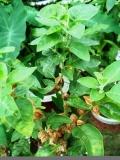Family: Solanaceae
Synonym: Physalis somnifera L.
Bengali/Vernacular name: Aswagandha.
Tribal name: Achothra (Garo).
English name: Winter cherry.

Description of the Plant: An erect herbaceous undershrub, 0.5-1.5 m high; branches terete, hoary tomentose. Leaves 5-10 cm long, ovate, subacute, entire, stellately pubescent.Flowers greenish or lurid yellow, usually about 5 together in a sessile or subsessile umbellate cymes; corolla 8 mm long. Berry red, smooth, 6 mm diam., enclosed in the inflated calyx, which reaches more than 2.5 cm diam.
Plant parts Used: Leaf, root.
Traditional
Uses: Powder made from root of the plant is taken with water two times a
day to treat cold and cough.
Ashwagandha churna when used regularly helps to improve the conditions like
senile debility, rheumatism, in all cases of general debility, nervous
exhaustion, brain-fag, low of memory, loss of muscular energy, and spermatorrhea.
A powder made with the dried root of the plant is taken with water two times a
day (3 g amount each time) until the rheumatic pain and inflammation of joint
is cured.
Regular use of Ashwagandha helps to reduce blood sugar and cholesterol levels.
Fine powder of root well mixed with oil is very use full in many skin
conditions.
A paste made with leaves when applied on a local inflammation acts as
anti-inflammatory.
Oil extracted from the root is useful in many conditions like paralysis,
epilepsy, sleeplessness etc.
The root of the plant is used for the treatment of weakness, impotence, hiccup,
and female disorder.
Distribution: Mostly cultivated in Bangladesh.
Is this plant misidentified? If yes, please tell us….















… [Trackback]
[…] Find More here on that Topic: natureinfo.com.bd/withania-somnifera-l-dunal/ […]